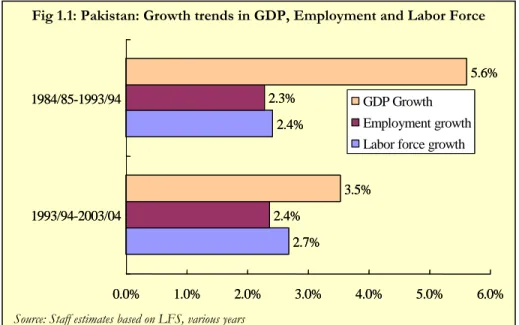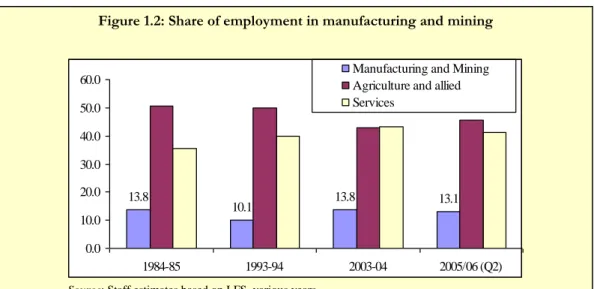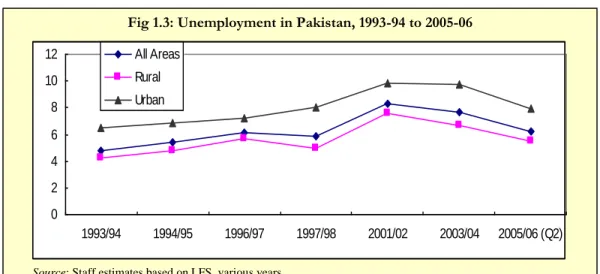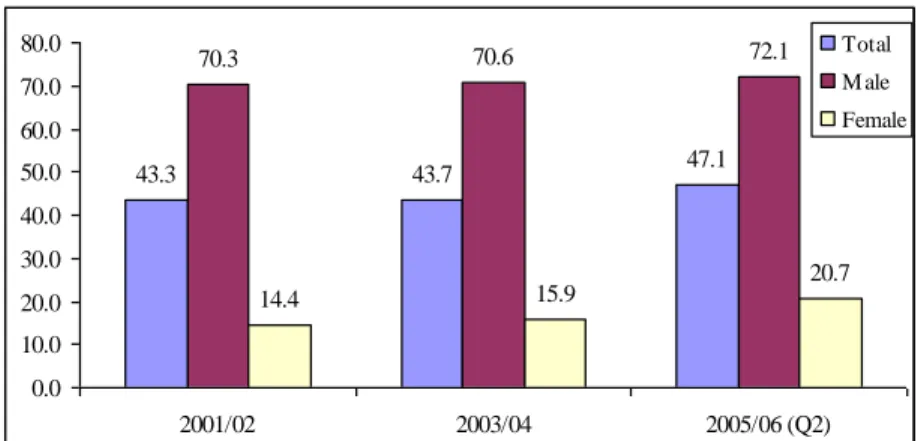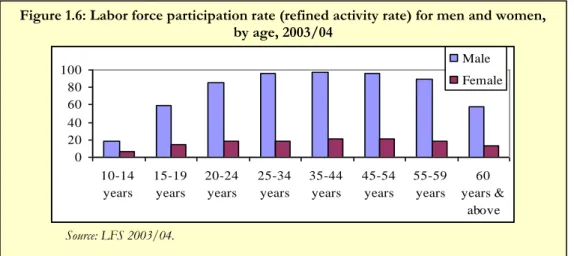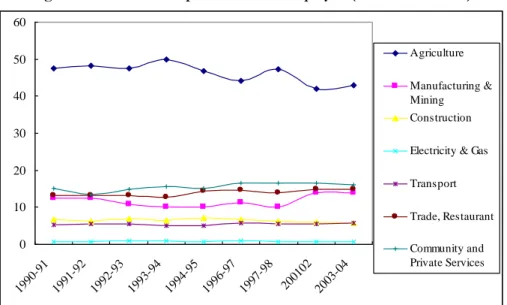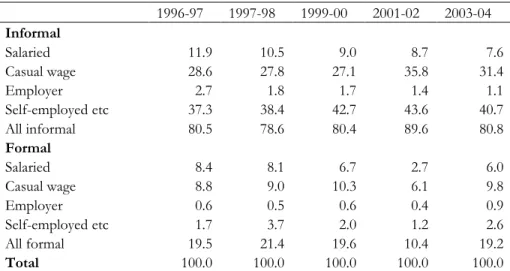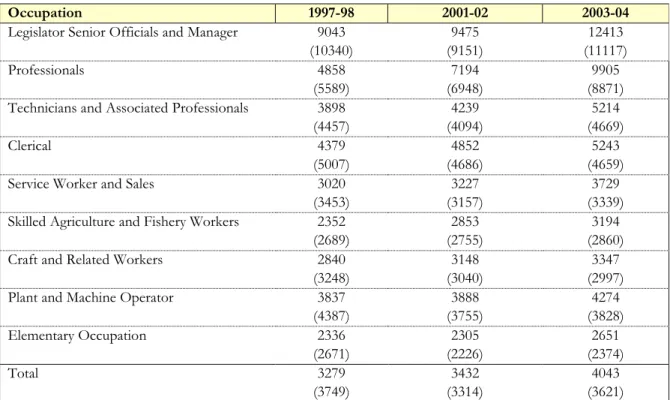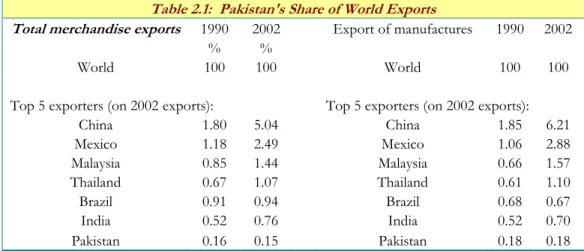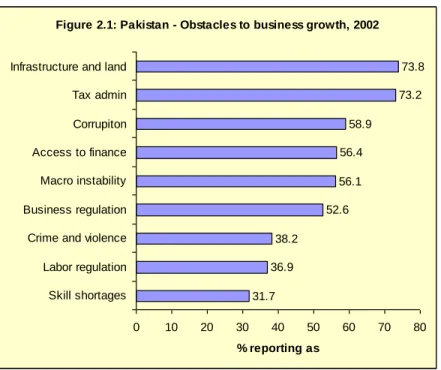REPORT No. 38075-PK
PAKISTAN
Labor Market Study: Regulation, Job Creation, and Skills Formation in the Manufacturing Sector
September, 2006
Finance and Private Sector Development Unit South Asia Region, The World Bank
Public Disclosure AuthorizedPublic Disclosure AuthorizedPublic Disclosure AuthorizedPublic Disclosure Authorized
T ABLE OF CONTENTS
ACKNOWLEDGMENTS ... i
FOREWORD ... ii
Executive Summary... iii
Policy Recommendations on Labor Regulation Reform ... v
Policy Recommendations on VTT Reform ... vii
CHAPTER 1: INTRODUCTION ... 10
Overview of Labor Markets in Pakistan ... 10
I. Introduction ... 10
II Overview of Labor Market in Pakistan ... 3
III. Summary and report outline ... 10
CHAPTER 2: BUSINESS ENVIRONMENT, LABOR MARKET INSTITUTIONS AND LABOR OUTCOMES ... 12
I. Introduction ... 12
II. Manufacturing sector’s performance ... 12
III. Overview of Pakistan’s investment climate ... 14
IV. Labor regulation and skills gap constraints ... 16
V. Conclusion ... 19
CHAPTER 3: LABOR REGULATION AND JOB CREATION ... 20
I. Introduction ... 20
II. Regulation and Rise of “Temporary” Labor ... 20
III. Impact of “Temporary” Labor ... 21
IV. Job Creation in Manufacturing Sector ... 22
V. Conclusion ... 25
CHAPTER 4: LABOR REGULATION AND SKILL FORMATION ... 27
I. Introduction ... 27
II. Labor force with low education ... 27
III. Incidence of OTJ training ... 29
IV. VTT as a response to skill shortages ... 30
V. Conclusion ... 32
CHAPTER 5: LABOR MARKET INSTITUTIONS IN PAKISTAN ... 33
I Introduction ... 33
II Labor Regulation ... 33
III. Issues and Challenges ... 39
IV. Impact of regulation and social security programs on employment patterns ... 44
CHAPTER 6: CONCLUSION ... 47
I. Introduction ... 47
II. GoP LM Reform Program ... 47
Annex 1: Labor Force (in Million) Various Years ... 59
Annex 2: Industrial Performance of Pakistan ... 60
Annex 3.1 A: Estimation and Interpretation of Labor Demand Elasticity Coefficients ... 62
Annex 4.1B: Labor Force Composition and on-the-job Training ... 68
Annex 5.1: Labor Laws – Repealed/Consolidated ... 71
Annex 5.2: Firing Costs ... 72
Annex 5.3: PROCEDURAL DIFFICULTIES OF FIRING WORKERS ... 73
Annex 5.4: Overview of Social Security Programs in Pakistan ... 74
REFERENCES ... 77
A CKNOWLEDGMENTS
The task team was led by Asya Akhlaque (SASFP) and included Rasmus Heltberg (SASHD) and Taye Mengistae (DECRG). Valuable inputs were provided by Eric Manes, and Namoos Zaheer (SASFP), Milan Vodopevic, Robert J. Palacios, Mansoora Rashid (SASHD), Ijaz Nabi, Manuela V.
Ferro, Tara Vishwanath (SASPR), and Maitreyi B Das (SASES). Guidance and useful comments for the VTT section of the report were provided by Michelle Riboud, Tahseen Sayeed, and Naveed Naqvi. The team gratefully acknowledges the excellent administrative support provided by Rubina Geizla Quamber, Kadija Jama and Sakm Abdul Hye (SASFP). Philip B. O'Keefe, Stefano Scarpetta, and Hong W. Tan served as peer reviewers. Simon Bell, Sector Manager (SASFP), provided overall guidance.
The report draws on background papers by Shahid Kardar and team (Pakistan Labor Markets institutional review), David Fretwell (VTT review), and Faisal Ghani (labor legislation review), commissioned as inputs for this study.
The authors gratefully acknowledge the guidance received from the Ministry of Labor & Manpower,
Ministry of Trade and Industry, Government of Pakistan, and the many private sector
representatives, federal and provincial government officials, labor union representatives, researchers,
and other stakeholders who participated in the consultation workshops held in Lahore, Karachi, and
Islamabad in January, 2006. The team also benefited from dialogue and collaboration with Robert
Heron (ADB) and Shukti Dasgupta (ILO). Financial support from Bank-Netherlands Partnership
Program on Global and Regional Initiatives through the South Asia window "Towards productive
job creation in South Asia" is gratefully acknowledged.
F OREWORD
The report is being produced at the request of the Ministry of Industries & Production & Special Initiatives, and the Ministry of Labor & Manpower, Government of Pakistan (GoP). The request emerged from the on-going policy dialogue under the Poverty Reduction Structural Credit (PRSC) programmatic lending operation, which supports, among other areas, labor law reforms. The study is directly linked to the GoP’s Poverty Reduction Strategy Paper (PRSP) and the Pakistan Country Assistance Strategy (CAS, 2006-08) which foresees labor market reforms as a key element in improving investment climate, accelerating growth and job creation in Pakistan.
Recognizing that fostering a conducive investment climate (IC) is a prerequisite for private sector
development, the government has put in place an impressive array of reforms for addressing the key
constraints faced by the business community. This report centres its lens on two elements of IC
constraints – labor regulation and skills gaps.In an effort to improve employment outcomes
and industrial productivity, the Government of Pakistan (GoP) has launched an impressive dual-
track reform process involving broad-based overhaul of labor laws and institutions, and expansion
and reform of the vocational and technical training (VTT) system. Accordingly this report (i)
assesses the effectiveness of the existing LM regulations and practices, including social security and
welfare program, and VTT system; (ii) analyzes the trade-offs by examining the relationship between
regulation, job creation and skills formation; and (iii) based on the analytical findings, it presents
policy options for strengthening the design of the on-going twin track reform strategy. It also
identifies priorities within (a) labor regulation i.e. labor legislation and its supporting institutions (b)
social security and welfare program; and (c) VTT system.
E
XECUTIVES
UMMARY1.1 In an effort to improve employment outcomes and industrial productivity, the Government of Pakistan (GoP) has launched a dual-track reform process involving broad-based overhaul of labor laws and institutions, and expansion and reform of the vocational and technical training (VTT) system. This is very much in line with the concerns raised by the private sector: about 30 percent of survey respondents in Pakistan identify labor regulation and skill shortages as major obstacles to business growth and productivity.
1.2
With the aim of helping inform the ongoing reform, this report investigates the links that exist in today’s Pakistan between labor regulation and the pace of job creation by the private sector, on the one hand, and skills formation, on the other. It also reviews the existing VTT system as the subject of the second reform track. The report shows that the rate of job creation we observe in Pakistan at the moment is far below what it should be partly because of the excessive regulatory burden existing labor laws impose on businesses. It also offers evidence that, beyond suppressing job creation, excessive regulation tends to aggravate the shortage of industrial skills by discouraging firms from sponsoring on-the-job training (OTJ) schemes. Because excessive regulation generally reduces the demand for skilled labor, it also has the potential to undermine the government’s effort to expand and reform the current VTT system. The report relies primarily on the global Investment Climate Surveys (ICS) and Doing Business databases, and the Pakistan Labor Force Survey (LFS). It also draws heavily on a series of new background papers on labor market institutions and VTT in Pakistan and on case studies and stakeholder consultations held as part of the underlying study.
1.3 Labor market regulation and laws are useful economic and social institutions designed to protect workers from undesirable consequences of market failure such as arbitrary or discriminatory actions by employers. They also help stabilize employment and household incomes against aggregate business cycles and shocks. Labor regulation is also an important element of society’s instruments for the provision of social security and the maintenance of health, safety, and environmental standards in economic activities. The stable and longer-term employment relationships that labor laws are intended to promote are also a source of productivity growth from the employers’ point of view in as far as they foster employee loyalty and provide the incentive for innovation and on-the- job skill formation. On the other hand, when excessive, labor regulation tends to choke off job creation; it can also undermine innovation and the development of industrial skills by raising the cost of durable employment relations. Unfortunately, this is what seems to have happened in Pakistan in recent years. Existing labor laws and regulation seem to have raised the cost of long-term employment relationship so high that the private sector is not creating good-quality jobs as fast as it should. Nor is it helping finance the training that Pakistan’s industrial workforce needs to effectively compete in global markets. The challenge of the ongoing reforms of labor laws is to reverse this situation by reducing the burden of labor regulation on businesses while helping provide workers with adequate protection from employment and income volatility and the adverse consequences of market failure.
1.4
Labor regulation in Pakistan is excessive by international standards, as can be seen from data
on a number of indicators of labor market flexibility. For example, Pakistan’s overall indicator for
restrictiveness of employment laws is the highest in the South Asia region, and is much higher than
indicators for the East Asian countries including Malaysia and Singapore. The most immediate
consequence of excessive labor regulation has been that, by the standards of countries with less stringent labor laws, recent employment growth by Pakistani firms has been too low for their rates of sales growth. In other words, the output elasticity of employment is lower than what would be expected with less restrictive laws. Indeed, the actual job creation gap between Pakistan and other developing countries would have been higher were it not for the fact that the effect of labor regulation in reducing demand for regular or permanent labor has been mitigated by its having led to greater reliance by firms on temporary labor than would have been the case with less regulation of permanent labor.
1.5 Thus, ironically, the most significant piece of evidence that labor regulation is excessive in Pakistan happens to be that the share of temporary workers in Pakistani businesses is one of the highest by any international standard, standing at about 36 percent against, for example, 15 percent in India, and 3 percent in Bangladesh. Since temporary workers are effectively denied coverage of the binding employment protection provision, firms that have a larger proportion of their workforce on temporary contracts would seem to have greater flexibility in adjusting their manpower to technological or product market developments. However, this advantage in the flexibility of staffing has to be weighed against the obvious advantages of stable and longer-term employment relationships from the point of view of both employers and workers. Key advantages of employment stability are loyalty and the constant upgrading of skills firms need to sustain within their workforce in order to remain competitive through innovation and the adoption of new technology. If firms choose to forgo these advantages of stable employment relationships, then it can only be because excessive regulation has raised the cost of the relationships to prohibitive levels.
This indeed is the case in the Pakistani industry at the moment. Firms seem to have responded to what seems to be costly regulation of permanent employment by relying on temporary labor to a greater extent than they would in a less regulated environment.
1.6 One aspect of the importance of long-term employment relationships to the productivity and international competitiveness of industry is that heavy reliance on temporary employment undermines the incentives workers and firms would have to participate in or sponsor on-the-job skill formation. As a result, although a far higher proportion of Pakistan firms reports skill shortages, only 15 percent of them sponsor on-the-job training, which is very low, even by developing country standards. This is significant for a country like Pakistan, where average levels of schooling are particularly low, as a result of which industrial skill shortages are acute. In the long run these shortages can be met only through improvement in enrollment and school completion rates and the expansion of tertiary education catering to the needs of industry. In the short run, however, OJT is the only means firms have of alleviating the shortages to any degree. Even in the well-developed educational setting of advanced economies, on-the-job-training is probably as important as formal education as a source of industrial skills.
1.7
All things considered, Pakistani industry and workers would seem to be better off with a
more flexible labor market. This would mean higher wage and output elasticities of industrial
employment than is actually the case at present, which in turn would mean higher job creation rates
at existing rates of output and wage growth. Although high output elasticity and high wage elasticity
mean greater volatility of employment incomes when taken in isolation from one another, in practice
the risk of greater volatility is likely to be low, as the two tend to compensate each other. At the
same time, greater labor market flexibility in the sense used here would put the economy in a
position to cope better with exogenous shocks to aggregate demand or to labor supply, or to other
factor markets than would be the case if labor demand were inelastic with respect to wages or output.
1.8
Because labor demand is derived demand, its elasticity depends on the elasticity of product labor demand, and hence on the competitiveness of the goods markets. One way to help Pakistan’s industrial labor market be more flexible is thus to help make domestic industry itself more competitive. A second and more direct, and probably more effective way is to reduce the cost and scope of regulation of permanent labor. The most immediate outcome of this would be faster job creation. An indirect benefit would be that greater demand by firms for skilled labor would also provide a sound basis for the GoP’s on-going effort to improve the VTT system, because such improvement would assume sustainable growth in demand for skills that excessive labor regulation could only hold back.
1.9
The report analyzes the existing labor laws and institutions, along with the new draft laws, from this point of view. It also provides a review of the current VTT system and proposed changes for it. We identify below a set of recommendation for further strengthening the labor law reforms and the reform of the VTT system.
Policy Recommendations on Labor Regulation Reform
1.10 To fully capitalize on the impressive on-going labor reform process in Pakistan, the Government needs to undertake a more concerted and multidimensional approach. That includes reform of the key binding elements in the existing federal legislation, re-engineering provincial enforcement and strengthening dispute resolution mechanisms. Reform in labor regulation should reduce firing and hiring costs as well as the cost of complying with legislation. It should also allow greater flexibility in staffing levels by allowing redundancy as a legitimate ground for dismissal and removing time limits on term contracts. Significant reduction in compliance costs can be achieved by simplifying inspection schemes, working condition norms, and mechanisms for the collection of social security contributions. Decreasing hiring and firing costs of permanent workers requires action on industrial dispute resolution and litigation rules and on severance pay schemes.
1.11
Reducing hiring and firing costs: Decreasing hiring and firing costs of permanent workers requireschanges in both legal provisions and implementation processes. Specifically, it should lower severance payments and reduce time required to report and resolve industrial grievances by simplifying and streamlining dispute arbitration and litigation rules. Currently, severance pay as a
proportion of base wages for a given period of continuous employment in Pakistan is twice what it is in India or Bangladesh.
1.12
Allow redundancy as fair grounds for dismissal. If a firm cannot fire excess workers in times oflow demand, it is less likely to hire in high times. This hurts both the worker and employers by leading to fewer jobs overall and less flexibility for the firm to grow. Australia, Denmark, Malaysia, Taiwan (China), Thailand, and Vietnam are some of examples of economies that permit redundancy firing. Pakistan should pursue a similar policy.
1.13
Remove time limits on term contracts.Pakistan permits term contracts for a maximum of only
nine months for jobs of a temporary nature. Such inflexibility in the timing and use of employees
limits companies’ ability to grow and thrive. Countries like China, Malaysia, Singapore, and New
Zealand place no limits on the duration of fixed-term contracts, and in so doing increase job opportunities for workers.
1.14
Recognizing the binding nature of this constraint,
the Employment and Services Act (ESCA) 2006introduces a major and laudable change to the classification of workmen by eliminating the current classification of permanent (more than nine months) and temporary (less than nine months) worker. The abolishment of ‘temporary worker’ will increase labor market flexibility by
eliminating the time limit on term contracts.The newly expanded conditions requiring that all contracts be in writing and allowing termination conditions to be incorporated is also a welcome addition, given that high explicit and implicit firing costs are important reasons why employers try to avoid hiring permanent workers.
1.15
One particular area of concern in the ESCA draft that may benefit from careful re- examination relates to the introduction of joint liability between principal employer and‘contractor’. This proposed change is motivated by the ground reality that much of the labor force
has been able to operate outside of the law due to a high degree of non-compliance. However, laudable the intention, the proposed approach may not be the right one. In addition, it may lead to other undesirable effects. The definition and use of the term contractor (and sub-contractor for labor) confuses whether a worker is an employee or a true contractor (in an outsourcing sense) by combining the two conflicting concepts. It is highly unusual, in conflict with case law, and likely inoperable, to have a both a contractor and his client to be jointly responsible for ensuring that the law is applied to an employee of the contractor. The provision requires that the client (principal employer) be ultimately responsible for compliance expenses which can then be recovered from the contractor. It is likely that this approach will lead to considerable contract disputes between businesses (contractors and their clients). This approach will ultimately prevent the emergence of
“outsourcing” a key business relationship to enhance productivity and competitiveness and to encourage the development of SMEs.
1.16
Reduce compliance costs associated with labor regulation.As part of the scheme for cutting down compliance costs, Pakistan should simplify labor inspection schemes, working condition norms, and mechanisms for the collection of social security contributions. It should also draw up a well- structured set of national regulations to guide inspection policy toward ‘best practice’ management characteristics. These could provide opportunities for federal and provincial authorities to limit rent seeking by consolidating the number of inspectors by introducing the concept of regulated limits on the discretionary power of inspectors, and by enabling the notion of a ‘risk-based’ inspection approach. In this regard the program would include: (i) the design and implementation of a nationwide inspection policy and implementation of regulations that may include a model regulation to guide provincial authorities responsible for the enforcement of the law; (ii) new business process systems preferably with electronic components to ensure efficient and equitable implementation; (iii) a training program for inspectors in the new aspects of the law, social skills and dispute resolution;
and (iv) a centrally or provincially managed third-party monitoring and evaluation system to ensure that inspections are taking place in the prescribed manner. Technical assistance should be sought to draw on global experience and apply best practice principles in design and implementation of a comprehensive program.
1.17
Compliance costs of social security contribution.The hassle and corruption involved in the
administration of social security contributions are major component of the cost of complying with
labor legislation. To reduce them, the system of levies involved should be rationalized and its
administration streamlined. Rationalization could be achieved by merging some of the existing schemes, maintaining only those services that workers appreciate, and passing on the resulting cost savings to employers. Merging the various programs would also help reduce the number of different inspections. To streamline administration, the system should be simplified into at most one or two programs providing umbrella services that could invest in modern administrative systems, with smart cards or similar ID-based technologies that ensure portability and coverage of workers and their dependents wherever they reside.
1.18
Increasing the effectiveness of social security contribution.Because the ultimate aim of the contributions is to provide social security for employees, reforms should also help assure their effectiveness from that point of view by expanding coverage and improving the governance of the scheme.
a.
Improve governance.Meaningful representation of workers and employers providing external control on the allocation of funds and the type of services could help improve governance.
b.
Expand coverage.Coverage can and should only be expanded after undertaking reforms that ensure meaningful, high-quality services for covered workers at a reasonable cost to employers. Expansion of the formal sector and reduction of evasion would ensure wider coverage at least in the formal labor market. Expansion to the informal sector will be slow and difficult, as the experience of other developing countries has proven, as it requires voluntary contributions by workers. The most appealing product, it seems, is often life insurance, as it is usually more difficult to get informal workers to pay for pension and health coverage. However, any expansion of the system will be conditional on prior reform that ensures the system provides benefits and services valued by workers and employers.
Policy Recommendations on VTT Reform
1.19
To meet the needs of several and growing client groups including matriculation (class 10) graduates, dropouts and the unemployed, and currently employed workers, the government has announced plans to expand the quantity and improve the quality of VTT system.
1.20 The government is considering major new investments to strengthen and provide leadership
for VTT, coordinate what is now a rather fragmented system, and administer the construction of
2,949 new institutions with a total capacity of about one million. This would increase current
capacity by 500%. To manage this expansion efficiently and to address problems with the existing
VTT system, the National Vocational and Technical Education Commission (NAVTEC) has
recently been established. The approach, while conceptually sound, has been implemented with
varying degrees of success in other countries. Pakistan needs to move forward carefully to ensure
that the proposed NAVTEC is effective, that new resources are used efficiently, and that
implementation is sustained after initial investments. In general the most successful NTEVTA
organizations appear to have the following characteristics: (a) are governing, not advisory boards,
having a majority of private sector members representing broad groups of employers in the large
and small scale sectors; (b) are removed from government civil service administration and hiring
regulations, are able to pay market rates for staff, are linked to broad high-level government
structures; (c) provide leadership in policy development, standards and accreditation, but in many
cases do not actually own and operate their own training institutions; (d) have a core of stable financing, often from state budgets or payroll taxes, but generate considerable revenue from sale of services to client groups; (e) have strong evaluation and planning units, and (f) at times are involved in curriculum development (but not always as this work is often left to service providers).
1.21 There is clearly a need to address problems with the existing VTT system including fragmentation, quality, scale, and lack of private sector ‘ownership’. The system suffers from a lack of
proper targeting, and an overly bureaucratic approach that stresses delivery over quality. If it is to be made morerelevant, it needs to be made more flexible and responsive to market needs. There is also a need to reassess where
public intervention is most needed, and what form this intervention should take.
1.22
Vocational & Technical Training for School Aged Youth: VTT policy makers are attempting to address the school drop-out issue by determining how more youth can be retained in purposeful education up to matriculation (grade 10), which is increasingly becoming the minimum requirement for entry and upward mobility in the world economy. In order to address this issue, Pakistan first needs to focus a significant portion of its limited education resources on upgrading quality and access to primary and intermediate general education in order to reduce dropouts. This level of education forms the base of all future education, including VTT, and provides essential skills for labor market entry in the emerging knowledge economy. Pakistan should not (as it has considered in the past) attempt to introduce VTT in intermediate schools, or a matriculation-tech stream at the secondary matriculation level (grades 9-10). Pakistan should, in addition to improving the quality of intermediate and secondary education, take specific steps to make this level of education, as well as grades 11-12, more purposeful and linked with the economy, labor market, and careers. Pakistan needs to expand and upgrade its vocational and technical education capabilities to provide skills training to individuals completing matriculation.
1.23
Vocational and Technical Training and Labor Services for School Drop-outs and the Unemployed. Thereis a need to help the large number of job seekers who are unemployed but want to gain entry to the labor market. Two approaches are recommended: (i) expand the VTT facilities in the country to provide additional infrastructure to address the skill development needs of the large number of unemployed and skill drop-outs who may lack skills or be structurally unemployed; (ii) pilot and experiment with provision of other labor services, in addition to institutional training, as is done in other developed and developing countries (including those with high levels of employment, uneven economic development, and specific problems in rural areas). NAVTEC should advertise the availability of funds, and contract with existing private, public, or NGO service providers to provide such services as: (a) in-depth job placement services, (b) subsidized on-the-job training (to be provided by enterprises), (c) institutional training, (d) small business technical assistance, and (e) incubator services including small amounts of working capital, and (f) local economic development planning grants. Small and Medium Enterprise Development Authority (SMEDA) should strengthen its leadership for small business development activities.
1.24
Continuing Education and Training for the Employed: There is a need to improve the skills of theexisting labor force, which in general has low levels of education and training compared to other
middle-income countries. It should also upgrade the skills of new labor force entrants. Pakistan
should support three existing and developing institutions which can directly address Adult
Continuing Education (ACE): the Technology Upgradation and Skills Development Company
(TUSDEC); the ongoing Skill Development Council (SDC), and SMEDA, which organizes a wide
range of technical and entrepreneurial services for micro, small, and medium businesses. All three
have different clientele and the initiatives should be supported and enlarged purely within the private
sector. The above initiatives should be demand driven, and financed primarily on a pay-as-you-go
basis by the enterprises requesting training services for their employees. Finally, existing VTT
training institutions could organize themselves to provide customized quick start training for
enterprises, although this requires highly entrepreneurial and flexible VTT institutions.
CHAPTER 1: INTRODUCTION Overview of Labor Markets in Pakistan
“The employment strategy must be embedded with an overall strategy for integrated human resource development that combines investment in human capital, the ‘supply side,’ with the creation of productive employment, the ‘demand side,’ to lead fuller utilization of human resources…”
Poverty Reduction Strategy Paper (PRSP), Govt. of Pakistan, Dec. 2003.
I. Introduction
1.1 Strengthening labor outcomes: The Pakistan PRSP recognizes the centrality of employment generation for poverty reduction. Indeed poor labor markets (LM) outcomes would seem to explain a big part of the poverty problem in Pakistan.1 The growth rate of the economy has been improving during the last four years but job growth remains slower than the increase in the labor force, which now includes more than 45 million workers (see figure 1.1). Job growth is slower than the rate of growth of GDP—while GDP grew by 3.5 percent p.a.
from 1993/94-2003/04, employment grew by 2.4 percent, corresponding to employment elasticity of 67 percent. There is little indication that the slow rate of job creation was compensated by
improvements in the quality of jobs; in fact, wages in existing jobs are low, especially in rural areas, and have stagnated in real terms over the last decade—real earnings declined during the second part of the 1990s and recovered somewhat thereafter, although casual workers still earn less in real terms than they did in 1993/94 (see Table 1.1). Formal sector jobs are scarce; most workers are either self-employed or employed in the informal or agricultural sectors, often at very low productivity. There has been no trend towards rising formality. Nor has there been a trend towards industrialization, at least in the sense that the share of workers employed in manufacturing and mining today, at 13 percent, is the same as it was 20 years ago (see figure 1.2).
Child labor persists, and some 2.5 million children in the 10–14 year age group and an unknown
1 Poverty in Pakistan has persisted at more or less the same level since the nineties. According to the World Bank’s Poverty
Assessment Report 2002, one third of the population in Pakistan can be classified as poor. Recent data indicates some improvement.
Fig 1.1: Pakistan: Growth trends in GDP, Employment and Labor Force
2.7%
2.4%
2.4%
2.3%
3.5%
5.6%
0.0% 1.0% 2.0% 3.0% 4.0% 5.0% 6.0%
1993/94-2003/04
1984/85-1993/94 GDP Growth
Employment growth Labor force growth
2.7%
2.4%
2.4%
2.3%
3.5%
5.6%
0.0% 1.0% 2.0% 3.0% 4.0% 5.0% 6.0%
1993/94-2003/04
1984/85-1993/94 GDP Growth
Employment growth Labor force growth
Source: Staff estimates based on LFS, various years
Figure 1.2: Share of employment in manufacturing and mining
13.8 10.1 13.8 13.1
0.0 10.0 20.0 30.0 40.0 50.0 60.0
1984-85 1993-94 2003-04 2005/06 (Q2)
Manufacturing and Mining Agriculture and allied Services
Source: Staff estimates based on LFS, various years.
Note: Workers in both formal and informal manufacturing and mining are included.
number of younger children are working.2The challenge for policy-makers is not only creating jobs for the unemployed3 and for the new entrants to the labor force but also further improving the productivity and earnings of the available jobs in order to reduce the very large number of ‘working poor’, and to improve the welfare of a large number of poor , marginalized or exploited workers. The rest of this chapter provides a brief summary of Pakistan’s labor market situation.
Table 1.1: Real job earnings, 1993/94-2003/04 (Rs. per year)
1993/94 1999/2000 2003/04
Rural Urban Total Rural Urban Total Rural Urban Total
Salaried 46624 67532 58188 44622 61582 55857 52150 71753 63162
Casual
wage 36274 47628 39873 31458 41682 35777 34063 41125 36513
Total 40534 60586 49336 36440 54026 46022 41457 60275 50036
Source: Staff estimates from LFS, various years
1.2 Key questions to consider are: were these not-so-positive labor market outcomes caused by too low employment content of the economic growth in Pakistan or was growth too slow to absorb the increase in the work force? This report argues that the second issue was at work—had economic growth been faster, labor outcomes would have been more favorable. In fact, there is emerging evidence that some labor market indicators have started to improve in response to the growth upsurge in recent years. Open unemployment has started to recede (fig. 1.3). The decline in real earnings appears to have halted and indeed begun to reverse since around 2001. The share of workers in self-employment has fallen a little. And more impressively, this has happened at a time when the labor market participation rate grew, especially for women. Despite these recent positive trends, Pakistan still has a long way to go to create more and better jobs.
2 There is also a persistent problem of bonded labor, although estimates of its extent vary widely.
3 Creating productive employment has been identified as a development priority in key official documents, including PRSP in Pakistan.
Fig 1.3: Unemployment in Pakistan, 1993-94 to 2005-06
0 2 4 6 8 10 12
1993/94 1994/95 1996/97 1997/98 2001/02 2003/04 2005/06 (Q2)
All Areas Rural Urban
Source: Staff estimates based on LFS, various years.
Source: LFS, various years.
II Overview of Labor Market in Pakistan
1.3 Pakistan has a low labor force participation rate (Fig. 1.4).4 Pakistan has a labor force of 45 million in a population of 150 million. This gives a so-called ‘crude activity rate’ of 0.3. The crude activity rate has stayed roughly constant since 1980, but has started to rise in the last few years: from 29.6 percent in 2001/02, to 30.4 percent in 2003/04, and 32.7 percent in second quarter of 2005/06. The so-called ‘refined activity rate’ (workers as a share of population age 10 and above) has also started to increase, from 43 percent in 2001/02 to 47 percent in second quarter of 2005/06.5 Participation rates are highest in the Punjab and lowest in the NWFP. Participation in the work force rises with the level of education of the worker (see fig 1.5).
1.4 Activity rates of prime aged males (25–54 years) have declined since the mid-1990s while those for teen-agers and youth rose. The female refined activity rate rose from 12.5 percent in 1990/91 to 15.9 percent in 2003/04 and 20.7 percent in 2005/06 (2nd quarter only). This is a remarkable demographic change, although female participation remains low when compared to men and in international perspective (see Box 1.1). Female participation in Baluchistan, NWFP, and Sindh are especially low. Male participation also rose, but less than that of women (see figure 1.4). All of this means that Pakistan could potentially see a dramatic expansion in the labor force as more men and especially women choose to enter the labor force in the future.
4 Labor force participation rate (LFP) is conventionally measured as the sum of the employed and unemployed divided by the working age population, (of those 10 years and over). An employed person is someone who worked during the reference period (for example, last week) for gain or family profit. The employed workers are usually divided into salaried, self-employed, unpaid family helpers, and employers. An unemployed is someone who was available for work and actively searching for work during the reference period. This group is sometimes referred to as ‘open unemployed’ in order to distinguish them from the underemployed, who are those that have some work, but not enough. Although underemployment is difficult to measure with any precision, there is no doubt that it is very prevalent in Pakistan, and from a poverty perspective, probably a much bigger problem than open unemployment.
5 According to estimates by the FBS based on the LFS data for the respective years.
Figure 1.4: Refined Labor Force Participation Rate, 2001/02 to 2005/06 (workers in percent of population age 10+)
43.3 43.7 47.1
70.3 70.6 72.1
14.4 15.9 20.7
0.0 10.0 20.0 30.0 40.0 50.0 60.0 70.0 80.0
2001/02 2003/04 2005/06 (Q2)
Total M ale Female
Source: FBS, various years, Government of Pakistan.
Box 1.1: Women and Work in Pakistan
While female labor force participation is low across South Asia, it is even lower in Pakistan, despite recent increases.
According to the Pakistan Integrated Household Survey (PIHS) from 2001/02, only one in four women above age 10 work, far lower than the 70 percent of men in that age who work (although still a higher figure than the Labor Force Survey, which undercounts female work due to short recall period). Why is it so low? It appears that both cultural and economic factors are involved.
Cultural explanations. A recent study (World Bank, 2005) investigated the reasons for low female work force participation in Pakistan, and concluded that mobility restrictions pertaining to women who have reached puberty play a major role in keeping women out of paid and unpaid labor. These mobility restrictions have at their heart genuine concerns about the safety of women in the public space, particularly safety when venturing outside the immediate settlement (the same mobility restrictions negatively impact female schooling). However, social concerns relating to the prestige and social stature of the family also have an impact — some male breadwinners are concerned that community members will perceive them to be inadequate and unable to provide for the economic needs of their family if their women work. Thus, there is social stigma attached to female work. For this reason, women in even quite poor households who desperately need additional income often refrain from working. The study concludes by recommending a comprehensive strategy to promote women’s work: investing in education and skills; facilitating women’s work, e.g., through job quotas; investing in time-saving infrastructure to free up women’s time (for example, easier water availability); and creating a legal environment to encourage women to participate in work.
Economic reasons also play a role. Poor households respond to economic opportunities that become available. Their most important and sometimes only asset is the labor of their members. When job options appear, male and female workers respond to them. A good example is that of Bangladesh’s garment sector.
The decade-long boom of the urban garments industry has had a major influence on Bangladesh’s female labor market, creating more than 1 million formal sector jobs for women. Previously, women with low educational attainment or from rural areas had been confined to the informal labor market, and female formal sector employment had been the preserve of a small educated elite. The speed with which families began allowing unmarried rural girls to take up urban employment, often away from the home, suggested that it was lack of economically rewarding employment opportunities more than cultural and social beliefs that discouraged Bangladeshi women from participating in the labor market. The willingness of rural households to send girls to the cities for work also suggests that the geographic mobility of the rural female labor force should not be underestimated. Formal sector employment opportunities for young women have proven to be an attractive alternative to early marriage, contributing to reductions in fertility and health- related problems caused by early marriage in Bangladesh. The Pakistani evidence also points in that direction: the rate at which the female activity rate has expanded during the recent growth period suggests a positive response to new opportunities.
Sources: Pakistan Country Gender Assessment: Bridging the Gender Gap – Opportunities and Challenges. The World Bank, October 2005. Labor Markets in South Asia, World Bank, 2004b..
Figure 1.6: Labor force participation rate (refined activity rate) for men and women, by age, 2003/04
0 20 40 60 80 100
10-14 years
15-19 years
20-24 years
25-34 years
35-44 years
45-54 years
55-59 years
60 years &
above Male Female
Source: LFS 2003/04.
Figure 1.5: Labor Force Participation rates (refined activity rate) for men and women, by education, 2003/04
Source: Staff estimates based on FBS, 2003/04, Government of Pakistan.
1.5 The labor force has been growing at 3 percent per annum in recent years against total employment growth of 2.75 percent. The incremental labor force, in other words, is not being fully absorbed. The rate of open unemployment has been growing from 4.8 percent a decade back to a peak of 8.3 percent in 2001/02 before falling back more recently to 7.7 percent in 2003/04, and 6.2 percent in second quarter of 2005/06 (the latest period for which data is available (Fig. 1.3). The burden of open unemployment falls disproportionately on youth, particularly the urban, educated youth, and the females (Fig. 1.4; Box 1.1).
Educated youth prefer to wait for lucrative work in sectors/jobs that are protected or provide greater job security (like government employment) and can afford to remain unemployed because they have fewer responsibilities and get income support from the family. This pattern is seen in many countries—open unemployment is a luxury the poor cannot afford. The real unemployment problem is much larger than implied by these numbers and comprises both chronic and seasonal underemployment of informal and agricultural workers, and a large but unknown number of ‘discouraged workers’ that have given up altogether and ceased to figure in the labor force, causing the low participation rate in Pakistan. Many women, in particular, can be considered discouraged workers. Once employment conditions improve many of these discouraged workers, including a large number of women, are likely to join the labor force, as indeed appears to have started to happen already.
0 20 40 60 80 100
Illiterate Primary Middle
Matric Intermediate BA & above Engineering Medicine Computer Science
% of those 10 years or older who active in the labor force Female Male
1.6 Occupations in Pakistan are dominated by ‘skilled agricultural worker’ (35 percent of the employed workforce), followed by ‘elementary occupations’ (20 percent). Over the last decade, there has been a more than 5 percentage-point decline in the share of agricultural workers (fig 1.7). Most of this decline was compensated by increases in the share of craft and unskilled occupations. Occupations in the
‘higher end’ that tend to pay better (managers, professionals, technicians, and clerks) constitute 19.3 percent of the employed in 2005/06 (Q2), and this share has only risen little (by 1.8 percentage-points) since 1996/97. The industrial employment structure for males differs substantially from that for females. Almost two-thirds of women are engaged in agriculture compared with 38 percent of men. Outside agriculture, female employment tends to be restricted to occupations such as teachers, doctors and domestic helpers (fig 1.8).
Figure 1.7: Occupational Composition of the Employed Pakistani Labor Force, in percent 1997/98-2005/06 (Q2)
9.8
3.0 3.0 1.8
6.0
39.9
12.7 3.7
20.1 11.4
1.5
5.1
1.3
5.0
34.1
14.9
4.2
22.5
0.0 5.0 10.0 15.0 20.0 25.0 30.0 35.0 40.0 45.0
Legislator and Senior Officials Professionals Technicians Clerks Sales & Service Skilled Agriculture Craft related Plant & Machinery Elementary Unskilled
1997/98 2005/06 (Q2)
Source: FBS, various years, Government of Pakistan.
Figure 1.8: Occupational Composition of the Employed Pakistani Labor Force by gender, 2003/04
11.5
2.0 4.9
1.6 5.2
34.9
15.9
3.8
20.3
0 10 20 30 40 50 60
Legislator and Senior Officials Professionals Technicians Clerks Sales & Service Skilled Agriculture Craft related Plant & Machinery Elementary Unskilled
Male Female All
Source: Staff estimates based on LFS, 2003/04, Government of Pakistan.
1.7 Sectoral levels and trends in employment. The agricultural sector employed 43 percent of the employed workers in 2003/04, down from 47.5 percent in 1990, with manufacturing and trade and services absorbing a growing share of the workforce (fig. 1.9). Agriculture always declines as part of the development process,6 and this speed of decline is not particularly high compared to many other countries. In Pakistan, industry is not the growth engine that it is in economies that have recently developed rapidly such as those in East Asia. Manufacturing activity accounts for only 18 percent of GDP, and despite some important early successes has performed far below potential. While the share of manufacturing in total employment displayed a rising trend during 1950-70, since then employment in manufacturing as a fraction of total employment has declined, remaining more or less constant at barely 10 percent in 1980s, rising slowly to 13.8 percent in 2003-04 (figure 1.2). Realizing the potential of industry is a top priority of the government.7
Figure 1.9: Sectoral Composition of the Employed (1990/91 - 2003/04)
0 10 20 30 40 50 60
199 0-91
199 1-92
199 2-93
199 3-94
199 4-95
199 6-97
199 7-98
200102 2003-04
Agriculture Manufacturing &
Mining Construction Electricity & Gas Transport Trade, Restaurant Community and Private Services
Source: FBS, various years, Government of Pakistan.
1.8 Within manufacturing, some 80 percent of workers are employed in the informal manufacturing sector (defined according to the LFS as enterprises with less than 10 workers) (see table 1.2). This share has been constant in the last decade, except for a spike in 2001/02, where it was 90 percent. Most manufacturing workers are casual or self-employed. Casualization of the workers has been on the rise. Only 13.6 percent of all manufacturing workers are regular salaried and less than half of these are in the formal sector. Not surprisingly, the regular salaried workers are on the decline although the trend may be beginning to change.
6During the period 1950-70 the share of agriculture in total employment saw a steady decline in total employment from 65 percent to 55 percent, and 49 percent in 1986/87.
7 See Towards a Prosperous Pakistan: A Strategy for Rapid Industrial Growth, Ministry of Industries, Production and Special Initiatives, Government of Pakistan, January 2005.
Table 1.2: Distribution of manufacturing sector workers, by employment status and formality, 1996/97-2003/04
1996-97 1997-98 1999-00 2001-02 2003-04
Informal
Salaried 11.9 10.5 9.0 8.7 7.6
Casual wage 28.6 27.8 27.1 35.8 31.4
Employer 2.7 1.8 1.7 1.4 1.1
Self-employed etc 37.3 38.4 42.7 43.6 40.7
All informal 80.5 78.6 80.4 89.6 80.8
Formal
Salaried 8.4 8.1 6.7 2.7 6.0
Casual wage 8.8 9.0 10.3 6.1 9.8
Employer 0.6 0.5 0.6 0.4 0.9
Self-employed etc 1.7 3.7 2.0 1.2 2.6
All formal 19.5 21.4 19.6 10.4 19.2
Total 100.0 100.0 100.0 100.0 100.0
Source: Staff estimates based on LFS, various years
1.9 Informality is widespread and has been growing. The informal sector (defined as those with less than 10 workers and engaged in non-agricultural, non-governmental activities) accounts for 70 percent of non-agricultural employment, and 55 percent of wage employment. Informal comprises 73 percent of workers in rural areas and 67 percent in urban areas (fig. 1.10). Informality overall grew by 5
Figure 1.10: Formality (percent of workers in non-agricultural employment)
14.3 14.4
18.2 13.5
16.4 13.9
11.8 12.6
15 19.2 13.5
16
73.9 73 66.8
67.3 70 70.1
0 20 40 60 80
1997/98 2003/04 1997/98 2003/04 1997/98 2003/04
RuralUrbanAll Areas
Informal Formal Government
Source: LFS, various years, Government of Pakistan,
percentage-points from 65 percent in 2001/02 to 70 percent in 2003/04. Some 61 percent of the employed labor force in 2003/04 was self-employed or unpaid family helpers--up by 2 percentage-points from 2001/02, although data from 2nd quarter of 2005/06 suggest that share may now have started to fall (see table 1.3). Lack of job opportunities rather than inherent entrepreneurial spirit is the main reason people become self-employed. Piece rated and casual employees account for 48 percent of total employees in 2003/04. Only one-fourth of workers in the informal sector are regular employees in contrast with 97 percent of those in government employment. The share of workers with job regularity fell from 55 percent in 1997/98 to 50 percent in 2003/04 partly because of the declining share of government employment. Job security, therefore, is non-existent for a large and growing majority of workers outside
government. Informal workers are not covered by most labour regulation, labor protection, or social security laws. They receive no pension when old. They often work very long hours at low pay.8
Table 1.3: Employment status (in %)
1993-94 2001-02 2003/04 2005/06 (Q2)
Employer 1.0 0.8 0.9 0.79
Self-employed and unpaid family helper 65.7 59.3 61.2 59.85
Employees 33.3 39.8 37.9 39.36
Total 100.0 100.0 100.0 100.0
Source: LFS, various years, Government of Pakistan,
1.10 Job earnings are low and Pakistan faces the double challenge of providing more jobs while also improving earnings and the quality of jobs. Average earnings for salaried employees in 2003/04 were Rs.4, 088 per month, equivalent to US$68. For a typical family of six with one person employed the average earnings places that family below the poverty line. Earnings for the self-employed are not available in the LFS, but from other surveys we know that the self-employed are more likely to be poor than the salaried. The Pakistan Social Safety Nets Survey, conducted in 2005, revealed much variation in the wage rate across interviewed households. The average wage received by households in the bottom quintile was Rs.86 per day, and many individuals in the sample received a much lower wage.
1.11 Underemployment—seasonal or chronic—is another problem facing many workers, especially those in self-employment or agriculture. Underemployment translates into income losses. Many workers in rural areas have three “inactive” months in a year where they are mostly unemployed, with some 40-60 idle days per year. Average earnings for poor rural workers are less than Rs.2000 per month.
1.12 Earnings differentials are large -- average earnings in rural areas are 68 percent of earnings in urban areas, while female wage employees earn 59 percent of males (although it is not clear if it is for similar work).
Earnings differentials between rural and urban areas have been diminishing, while those between men and women have been increasing. There is a high wage premium to education and to the regularity of the job.
1.13 Real earnings declined markedly from 1997/98- 2001/02, and recovered somewhat thereafter.
However, real earnings remain lower in 2003/04 than in 1997/98 (by some 3.5 percent). The main reason for declining real earnings is a combination of high labour force growth rate, drought, and sluggish economic growth. There is little doubt that the low and declining real wages attenuated by the casualization of the job structure provides a key explanation of the increase in poverty during much of this period.
1.14 Wage outcomes are not equally negative for all groups (see Table 1.4). For elementary workers, the focus of the Minimum Wage Legislation, average real earnings eroded by 11 percent from Rs. 2,671 in 1997/98 to Rs. 2,374 in 2003/04 (in 2000/01 prices). Real earnings in the private sector fell more in the informal than in the formal sector. In contrast, government employees saw real wages improve by 21 percent on average. Real earnings improved in some industries -- community, social and private services, finance and real estate, transport and electricity/gas -- some of which are dominated by the public sector. Real wage gains were also made by some of best-paid professional categories. The rest experienced falling real earnings, with a sharp fall in real wages of illiterate or less-educated workers.
8 Special surveys of informal sector workers have revealed that they work long hours, in some case beyond 60 hours a week (Kemal and Mahmood, 1993).
